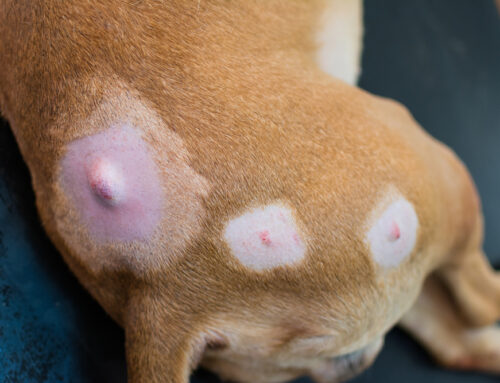If your pet is constantly scratching, chewing at their skin, or showing signs of irritation despite flea treatment, they may be suffering from Flea Allergy Dermatitis (FAD). This common condition isn’t just about having fleas—it’s an allergic reaction to flea saliva, and it can cause significant discomfort even from a single bite.
At Providence Vet, we frequently treat dogs and cats affected by FAD. We know how frustrating and painful it can be—for both pets and their people—and we’re here to help you understand, treat, and most importantly, prevent this allergic reaction before it causes long-term problems.
Ready to take control of your pet’s flea issues?
Contact us today to schedule an exam.
Understanding Flea Allergy Dermatitis
What Exactly Is FAD?
Flea Allergy Dermatitis is a hypersensitivity reaction to proteins in flea saliva. That means even if your pet only gets bitten once or twice, it can result in a severe immune response. In allergic pets, the body overreacts to the bite, triggering intense itching, inflammation, and damage to the skin.
Not all pets are allergic to fleas, but for those who are, even the cleanest home and the briefest exposure to fleas can set off a flare-up. This is especially common in pets with other underlying sensitivities or a history of allergies.
For more in-depth information about flea allergies in cats, visit the Cornell Feline Health Center.
Common Symptoms of FAD
Flea allergy symptoms often show up in specific locations on the body, especially near the tail base, belly, inner thighs, and lower back. The itching can be so intense that pets may scratch or chew themselves raw, leading to open sores, hot spots, and infections.
Some hallmark signs include:
- Persistent scratching, biting, or licking
- Hair loss, often in symmetrical patches
- Red, inflamed skin or raised bumps
- Scabs or crusted lesions
- Foul odor from infected skin
Cats with flea allergies may show more subtle signs, such as overgrooming or small scabs around the neck and shoulders. Dogs tend to show more widespread hair loss and skin trauma.
For more detail on these symptoms, check out the Merck Veterinary Manual’s overview on FAD.
Diagnosing Flea Allergy Dermatitis
What to Expect During Your Visit
At Providence Vet, diagnosing flea allergies involves ruling out other possible causes of skin irritation, such as food sensitivities, environmental allergies, or parasitic infections.
Here’s how we approach it:
- A thorough physical exam to check for flea dirt (flea droppings), scabs, redness, and pattern of hair loss.
- Skin scrapings to rule out mites, yeast, or bacterial infections.
- In some cases, allergy testing may be recommended to differentiate between flea allergy and other causes of dermatitis.
- A therapeutic trial of flea control—if symptoms improve with consistent flea prevention, this supports a diagnosis of FAD.
Learn more about managing pet allergies from Purdue Veterinary Hospital’s allergy tips.
Treating Flea Allergy Dermatitis

Flea Prevention Is the Foundation
For pets with flea allergies, prevention isn’t optional—it’s essential. Even one flea bite can trigger a severe reaction, so the goal is zero exposure. Unfortunately, over-the-counter flea treatments often fall short for pets with FAD.
We recommend veterinary-prescribed flea control year-round, regardless of the season. In Virginia Beach, fleas thrive in every month of the year thanks to our mild winters.
Effective options include:
- Topical preventatives like Advantage, Revolution, or Bravecto
- Oral preventatives such as Simparica, NexGard, or Capstar
- Flea collars like Seresto, which offer up to 8 months of protection
For a broader discussion on the importance of consistent parasite control, visit AAHA’s guide on year-round flea prevention.
Managing Itching and Secondary Skin Infections
When pets are actively flaring, they may need more than just flea control. Treating the inflammation and infections caused by constant scratching is equally important.
Depending on severity, treatment may include:
- Medicated shampoos or sprays to soothe skin and remove allergens
- Antibiotics or antifungals if infection is present
- Antihistamines or steroids to break the itch-scratch cycle
- Omega-3 fatty acids to reduce skin inflammation and promote healing
Regular grooming helps prevent matting, distribute natural skin oils, and gives you an early heads-up if symptoms are returning. For more grooming tips, check out this ASPCA article on why grooming matters.
Preventing Flea Infestations at Home
Why the Environment Matters
One of the most challenging aspects of treating FAD is that most of the flea population lives in your home, not on your pet. Fleas go through four life stages: egg, larva, pupa, and adult. While adult fleas live on pets, the other 95% of the population may be hiding in your carpet, pet bedding, furniture, or floorboards.
That’s why treating your pet alone isn’t enough—you must address the entire environment to break the cycle.
Visit the CDC’s resource on flea lifecycles to better understand how fleas spread and survive.
Environmental Control Measures
To fully eliminate fleas from your home, we recommend:
- Frequent vacuuming, especially under furniture and along baseboards
- Washing pet bedding and blankets in hot water at least weekly
- Using indoor flea sprays or foggers that target eggs and larvae
- Treating all pets in the household—even if only one seems affected
If you prefer more natural options, some helpful tools include diatomaceous earth (a fine powder that dehydrates flea larvae), cedarwood bedding, and lemon or vinegar-based sprays for lightly misting pet-safe areas.
When to Call Providence Vet
FAD can spiral into serious skin infections, weight loss, or behavior changes if left untreated. If your pet:
- Can’t stop scratching, biting, or licking
- Has visible sores or hair loss
- Seems uncomfortable or irritable
- Isn’t improving with over-the-counter flea products
…it’s time to get help. Our team can diagnose the issue, prescribe safe and effective treatments, and help you craft a prevention plan tailored to your pet’s lifestyle.
Schedule an appointment with Providence Vet today.
Your Partner in Flea Allergy Management
Flea Allergy Dermatitis is more than just a nuisance—it’s a medical condition that can cause significant pain and distress for your pet. But the good news is that with year-round prevention and the right veterinary support, FAD is absolutely manageable.
Don’t wait until your pet is uncomfortable. Whether you need help choosing the best flea product or your pet needs immediate relief, the team at Providence Vet is here to help.
Visit Providence Vet to build a flea prevention plan that works for your pet—and your household.






Leave A Comment